|
Memphis THEATRE SHOWMEN |
|
|
|
...The
Early Theatre Impresarios and Moguls |
|
|
|
|
|
|
Theatre troupes began touring Memphis as early as the 1800s.
And the first real theatres were built in the city around
1850. The pattern of building new theatres increased well
into the 1900s opening the way for well know performers and
entertainers to visit the city. The Victorian era in
America marked the first "real" theater for Memphis. Great
actors had risen to fame, like Lillie Langtry, Otis Skinner,
Edwin Booth and Sarah Bernhardt. They all performed in
Memphis during this rise of theaters and opera houses.
And Memphis had its share of “impresarios,” that is, the
person who organized entertainments for the public. Many of
them ran highly successful theatres for years and with the
later arrival of vaudeville, they quickly combined Opera,
Drama, and Vaudeville acts. |
 |
|
|
 |
These early impresarios were the first to recognize the
possibilities of film as a popular medium. In the
early 1900s a few canny producers, began to intersperse
short films among the live acts, seeing the potential
for drawing a larger audiences, including people who
wouldn't think of entering a vaudeville house.
Because the early shows cost only a nickel or dime,
they became the dominant form of mass entertainment.
And new theaters began to open on every block along Main
Street. Some blocks might have several theaters.
To keep up with the demand, the impresarios oversaw and
developed a constant flow of new entertainers each week
to make sure that the crowds continued to come back
regularly. They had to run a tight, and possibly
stingy, ship. Perhaps they were able to do this
because so many were immigrants or had been actors
themselves.
This is their story - the
managers, impresarios, and moguls. |
|
|
|
|
|
|
|
| |
Click on small photos to enlarge them.
|
|
|
|
|
|
|
W. H. Crisp
...and Crisp's Gaiety Theatre |
|
|
 |
 |
 |
|
 |
| W. H. Crisp |
Eliza
Crisp - wife |
Crisp's
Gaiety |
NY Herald - 1857 |
Jenny Lind |
|
|
|
|
The W. H. Crisps immigrated to the
United States in 1844 from England. Although they were
classical actors W. H. Crisp primarily managed theaters and theater
companies in New Orleans, Savannah, Augusta, Memphis, and
Nashville. During the Civil War, he served in the Confederate
Army, teaching the troops a skill he had learned as an actor - sword
fighting. His son Harry became a popular New York actor,
Another son Charles, became a judge and Congressman. His
daughters Cecilia and Jessie formed their own repertory company and
toured. His Memphis Theatre was called Crisp's Gaiety
and was one of the two theaters listed in the earliest Memphis
Directory of 1859. Crisp's Gaiety was on Jefferson, near
3rd. It was constructed in 1857 at a cost of $40,000, and was
lavishly decorated. Crisp booked famed Opera Diva Jenny Lind,
who first sang in Memphis at this Theatre, during her first American
tour. The Crisps moved to Texas in 1870. Eliza died in
1873 and William died in 1874. |
|
|
|
|
Their son, Charles F. Crisp, born in England, settled in Georgia
with his parents. Acting was not a career choice for
him. He became a prominent politician ... Congressman from
Georgia and Speaker of the House. The letter (below) was
written by William to his son, Charles in 1854. It is in the
collection of Francis J. Crown, Jr., who has shared it with this
website. |
|
|
 |
 |
 |
 |
 |
 |
| Crisp Bulletin
1860 |
Detail 1960 |
Crisp
Envelope 1854 |
Crisp Letter |
Letter,
page 2 |
Crisp's son |
|
|
|
|
|
|
|
|
|
|
|
Leubrie Brothers
-
Ellis, Louis, Jacob
...and Leubries Theatre ... New Memphis
Theatre |
|
|
|
|
|
Photos of
Louis, Ellis &
Jacob Leubrie ??? |
|
 |
 |
 |
 |
| |
Leubries - New
Memphis |
Bernhardt
1880-81 |
Wilde 1882 |
NY Mirror 1884 |
|
|
|
|
|
|
Ellis and Louis Leubrie were brothers from St. Louis who
purchased the building at 82 Jefferson and renamed it Leubrie's
Theatre.
Oscar Wilde lectured at Leubrie's in 1882. Sarah Bernhardt's
first American tour played there in 1880-81. Opera was the
biggest draw: Abbott's Opera Co appeared in 1880, 1882 and
1887. Weber's Opera in 1883. Ford's Opera Co appeared in
1884. The Leubrie brothers had a major business reversal
around 1887 and were compelled to sell the theatre. After it
was sold, the theater was renamed "The New Memphis". Ellis
then became manager of The New Memphis. Several other managers
associated with Leubries and the New Memphis are
Frank Gray
,
Joseph Brooks, and T. W. Davey.
In 1876-77, the Leubrie brothers were involved with
other businesses in Memphis - "Fancy Goods" at 222 Main,
Cigars and Tobacco at 235 and 277 Main. |
|
|
|
|
 |
 |
|
 |
|
NY Mirror 1888 |
|
 |
|
|
 |
|
NY Mirror 1890, |
|
 |
|
|
 |
|
NY Mirror 1890, |
|
 |
|
|
New Memphis
1886-88 |
NY Mirror 1882 |
NY Mirror 1884 |
NY Mirror 1903 |
NY Mirror 1885 |
|
|
|
|
|
|
|
|
|
|
|
|
Along with
"real theatre", another type of theater
was developing - "Variety
Theatre".
It flourished in Memphis and catered to large stag audiences.
The programs were similar to Vaudeville (song, dances, dumb acts,
specialty numbers, sketches), but the Variety Halls added a liberal
supply of song and dance girls, and pretty waitresses serving
drinks. The Memphis Halls soon acquired the name "low
varieties". With these halls opening and closing on a regular
basis, managerial careers were often short and unprofitable. A
successful manager had to be forceful and wear at least three
hats - host-talent booker, bouncer, and saloon keeper.
Many very successful managers of the period learned their
trade or served their apprentice-ship in the Variety Halls. |
|
|
|
|
|
|
|
|
|
|
|
Frank Gray
...
and the
Grand Opera
House ...Leubries ...Memphis ...Lyceum Theatres |
|
|
 |
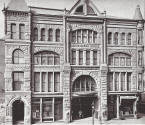 |
 |
 |
 |
|
Frank Gray
|
Grand Opera House |
Lyceum Theatre |
Lyceum Season |
Lyceum |
|
|
|
|
Frank Gray
was a Memphis newspaperman, who was interested in Theatre. He began his work in the Theatre as
an usher at Leubries, becoming a Business Manager, and then Acting
Manager, and Manager. He was manager at all of the leading
theaters of Memphis. Gray was considered a clever and capable
manager who booked only the best attractions, and he was known as the "Dean of Southern
Theatre Managers". Check the impressive list of bookings
(below) he made for the Lyceum's 1907 season. |
|
|
 |
 |
 |
 |
 |
|
1891
Directory |
The Memphis |
Lyceum 1907 Season |
Lyceum 1891 |
Gray Obit -Variety 1922 |
|
|
|
|
|
|
|
|
|
|
|
|
|
|
|
|
|
|
|
|
|
|
|
|
Col. John D. Hopkins
... and Hopkins Grand
Opera ...Lyceum Theatres |
|
|
 |
 |
 |
 |
 |
|
Col
Hopkins |
Hopkins Grand Opera House |
Hopkins Stock Co. |
Hopkins 1906 |
Hopkins Obit - 1909 |
|
|
|
|
The Grand Opera House was built in 1890 and John D. Hopkins
purchased it in 1899 - renaming it Hopkins Grand Opera House.
Hopkins' background was in Vaudeville and Minstrel Shows. He had
vaudeville theaters in Chicago and in St. Louis, and his own
Vaudeville troupe name "Hopkins Transoceanic Star Specialty Co." Once he took
control of the Grand Opera, he immediately hired his own resident Stock Company, and
went about changing the house into a Vaudeville Theatre. He
replaced the gas lighting with 586 sparkling lights and changed the
color of the foyer from a drab olive to a brighter gray and gold.
He completely renovated the house in 1903 and the color scheme was
changed again to rose and gold, with the boxes accented with green
and yellow. Of course the primary fare was Vaudeville, but in
1906, the most popular act was the great Sarah Bernhardt. When
the Grand Opera opened in1890 there were a series of managers
(including T. J. Boyle and Frank Gray) during the first 10 years.
When Hopkins took over, he installed Anderson B. Morrison, who was
the manager for the next 6 years. Morrison was considered one
of the most popular managers in Memphis. Hopkins was a
wheeler-dealer. Around 1906 he was involved in a lawsuit
because he planned to sub-lease the Opera House to a Burlesque
Circuit. This suit may have led to the Orpheum Vaudeville
Circuit being able to take over the house in 1907. |
|
|
 |
 |
 |
 |
 |
|
Hopkins Description |
Variety 1906 |
The Lyceum Theatre |
The Choctaw 1899 |
Hopkins Bookings
|
|
|
|
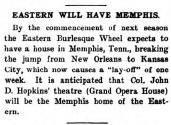 |
 |
 |
 |
 |
 |
|
Lease Opera House to Burlesque? |
For Sale |
Unsold |
1894 |
Bigamy Lawsuit 1899 |
Obit 2 |
|
|
|
 |
 |
 |
 |
|
Daughter's notice 1909 |
NY Clipper 1905 |
Hopkins Transoceanic 1898 -
1900 |
|
|
|
 |
 |
 |
 |
 |
| Trans-Oceanic
Token |
Hopkins-obit |
HHopkins-obitopin |
Ethel
Hopkins - daughter |
Trans-Oceanic
Poster |
|
|
|
|
|
|
|
|
|
|
|
|
A. B. Morrison
...and the
East End
...Hopkins Opera ...Orpheum ...Jefferson ...Lyceum ...Pantages
Theatres |
|
|
|
 |
A. B. Morrison was
the first Vaudeville manager in Memphis. He became a
popular, experienced theatre-man who knew the business
intimately. He was especially appreciated for his quiet
personality and his efficiency in business.
It appears that
Morrison may have successfully managed most of the early
theatres in Memphis - going back to the East End Playhouse
around 1900. He was instrumental in getting The
Jefferson Theatre (Lyric) built and became its first manager.
At other times, he managed Hopkins Opera House, The Orpheum,
The Lyceum and became manager of The Pantages in 1925 |
| A. B.
Morrison |
|
|
|
|
|
|
|
 |
 |
 |
 |
| Billboard
1905 - East End |
Billboard
1913 - East End |
Billboard
1948 - Obit |
| |
|
|
 |
 |
|
| Billboard
1909 - East End |
Billboard
1909 - Jefferson |
|
Morrison
1905 |
|
|
|
 |
 |
 |
 |
 |
 |
|
East End
Playhouse |
Hopkins Grand |
Jefferson |
Lyceum |
Orpheum |
Pantages |
|
|
|
|
|
|
|
|
|
|
|
|
Benjamin M. Stainback
...and the
Auditorium ... Bijou
Theatres |
|
|
|
Photo of
Benjamin
Stainback |
|
 |
 |
 |
 |
| |
Bijou |
Auditorium 1901 |
1917 Switch Theatres |
Bijou 1909 |
|
|
|
|
The Auditorium was
probably the first real Cinema in Memphis and where, in 1897, the new
Cinematograph was first demonstrated in the city. Edison's
Concert Phonograph also had its Memphis debut at The Auditorium.
The Auditorium opened in 1894 and lasted until 1903. It was located at S.
Main and Linden in a huge barn which had been used as a garage for horse-drawn
carriages. When electric trolleys replaced the carriages, the
building was converted to a theatre. The Auditorium building was
extensively remodeled in 1903 and renamed the Bijou. The building burned down in 1911. Sometime after 1918
it was supposed to have been rebuilt. We can find
no record of that in the City Directories. Benjamin M. Stainback started
out managing the Auditorium and continued a very successful
operation when the name was changed to the Bijou Theatre. A
particularly important booking was the United Confederate Veterans
Reunion of 1909. The Bijou was located near the Orpheum,
approximately on
the site of the Chisca Hotel. After the Bijou, Stainback is
listed as manager of LOEW'S Lyceum in 1920. |
|
|
 |
 |
 |
|
 |
|
NY Clipper - Fire 1911 |
|
 |
|
|
 |
|
NY Mirror - 1903 |
|
 |
|
|
1900 Directory |
1920 Directory |
1902 Description |
NY Mirror - 1915 |
NY Mirror .
1911 |
|
|
|
|
|
|
|
|
|
|
|
|
|
|
Charles Dinstuhl
...and the Theatorium Theatre |
| |
 |
 |
 |
 |
|
 |
|
Billboard
1908 |
|
 |
|
|
C. M.
Dinstuhl |
Theatorium
|
1908
Directory |
Billboard
1909 |
Billboard
1908 |
|
|
|
|
Charles Dinstuhl was a "candy man" - and a clever one. He
realized a connection between "snacks" and theatres, so in 1905 he
opened The Theatorium at 156 N. Main, next door to his
confection Shop. This is generally considered Memphis' first
Nickelodeon movie theatre and the first theatre where films were the
main attraction. Between films, singers sang as slides were
projected on screen. It was a huge success and in a short time
no less than twenty of these theatres were scattered around Memphis.
The city recognized a good thing and imposed a license of $400 per
year on these theaters, payable in advance. This put
several out of business but The Theatorium was successful.
Films shown at The Theatorium included "The Great Train Robbery" and
the theater became part of the "Crystal Circuit. There may
have been 3 different Theatoriums in the city.
Sol Dan and W. H. Wassman
are other managers associated with The Theatorium. In 1908
The Theatorium at 156 N. Main was purchased by Frank Montgomery and
was renamed "Majestic #1" - the first in a chain of Majestics.
Charles was born in 1898 and died in 1981. The Theatorium is
long gone, but the fifth generation of Dinstuhl's is still making
fine candies in Memphis.
Does a photo exist of the THEATORIUM Theatre??? |
|
|
|
|
|
|
|
|
|
|
|
Jack
Amick ...
and the Palace Theatre - Amick's Vaudeville Exchange. |
|
|
 |
 |
 |
 |
 |
|
Jack Amick |
Jack Amick |
Palace on Main |
Amusing Memo |
Palace - Billboard 1908 |
|
|
|
|
Jack Amick was perhaps the first real "showman-manager" of Memphis.
He owned the Palace Theatre at 135 N. Main, which premiered in 1907.
It opened as a moving picture house, but later Jack added vaudeville
acts with seven performances daily - 30 minutes each - three in the
afternoon and four in the evening. This innovation met with
immediate success and the Palace drew crowds each day. Jack
had been an actor and after forming the Amick Vaudeville Exchange,
he created a circuit of theaters in the South and operated theaters
in Meridian, Hattiesburg, Biloxi, Mobile, Pensacola, New Orleans,
Baton Rouge and Shreveport. The performers he hired spoke of
him as being one of the best managers in the business. In 1908
Jack Amick also became the first manager of The Lyric Theater in
Memphis. He never completely gave up performing and later
moved to Chicago and New York where he continued managing theaters
as well as performing. As an actor-manager, Jack Amick was one
of the first to take advantage of major advertising - not only for his
theaters, but for himself. A true showman! |
|
|
 |
 |
 |
|
Billboard Ad - 1907 |
Billboard Ad - 1908 |
Billboard Ad - 1908 |
|
|
|
|
|
|
|
|
|
|
|
|
|
|
|
|
Huddleston Brothers
...
and the Ruby Amusement Co. |
|
|
|
Please help us
locate a photo
of Huddleston Bros? |
|
 |
 |
 |
| |
Ruby
Theater |
Billboard Ad - 1909 |
Billboard Ad - 1909 |
|
|
|
|
We
have not been able to locate any biographical information on the
Huddleston Brothers. |
|
|
|
|
|
|
|
|
|
|
|
Frank Montgomery
*
and the Majestic Theatres - Majestic Amusement Co. |
|
|
 |
 |
 |
 |
 |
|
Frank Montgomery |
Majestic |
Majestic |
Majestic - Interior |
Montgomery - "Button" |
|
|
|
|
Frank Montgomery, 'the Moving Pictures Man of Memphis" was the
ultimate "showman". In 1908 he purchased The Theatorium from
Charles Dinstuhl and renamed it the Majestic #1. It became the
first of many Memphis theaters owned by Frank Montgomery.
According to numerous references in vintage periodicals
of the time, he owned
4 to 8 Majestic Theaters and The Columbia (Princess). He also owned
theaters in Atlanta, Jacksonville, and Chicago. Montgomery was
considered a master of advertising. It was said of Frank that "Here
was the beginning of class and quality which made the Montgomery
name famous throughout the South". He first announced that his
theaters would feature nothing but pictures - no vaudeville.
Frank reasoned that the public had never really seen first class
films - that they were accustomed to seeing old films, painfully
blurred and with frequent breaks of the film. He organized
"The Majestic Amusement Company" and proceeded to order new films.
purchase the best of equipment, develop better lighting and give the
patrons better ventilation. And it pleased the ladies
when Frank decorated the exterior and interior of the house with
plants. Frank also demanded the best service from his
operators, doormen, cashiers, and all other employees. In
effect, he put real snap into his shows by engaging an orchestra
instead of the usual lone piano player. If the Majestics
weren't enough, the Majestic Amusement Company also managed all the
Empire Theaters in Memphis. In 1919 the Majestic Amusement Co
became "Memphis Enterprises" and in 1921 "Consolidated Enterprises",
taking on partners R. C. Tarlton and C. T. Bridges. Frank
Montgomery spent money and made money. He was a
class act! |
|
|
 |
|
1909
Ad |
 |
|
 |
 |
|
 |
|
1917
Ad |
|
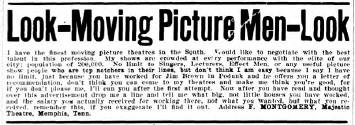 |
|
|
1909 Ad
|
Majestic-Strand |
Montgomery Bus. Card |
1909 Ad |
|
|
|
|
*
Frank T. Montgomery has comprehensive coverage on another page of
this website >
Click Here. |
|
|
|
|
|
|
|
|
|
|
|
Charles A. McElravy
...and
Ellis Auditorium + others |
|
|
|
|
|
|
 |
 |
 |
 |
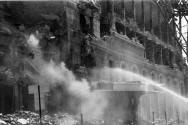 |
|
Charles McElravy |
Ellis - 1930 |
Dedication |
McElravy Group Meeting |
Sad Day 1999 |
|
| |
|
Charles A. McElravy
(1878 - 1961)
was General Manager of Ellis Auditorium from its opening in
1924 until his retirement in 1951. His many responsibilities
included booking the talent, drafting the contacts, insuring
each shows success, etc. Ellis was profitable the
last 22 of his 27 year career.
In his honor, 'The Charles A. McElravy Award' was created in
1963, honoring this International Association of Auditorium
Managers pioneer and citing current members "for contributions
to the IAAM and the profession of auditorium management."
It is a very prestigious International Award. But McElravy's
career hadn't begun with Ellis. He came to Memphis in 1904 to
manage several amusements at the old East End Park. In 1906 he
was general manager of the distributing branch of the American Film
Corporation. In 1908 he became the general manager of Frank
Montgomery's Majestic Amusement Company, where he managed 4 theaters
until 1919. By 1921 he had 16 theaters under his
direction, including several in Jackson, Chattanooga, Johnson City,
and Knoxville. For 4 of these years he was also president of
the Motion Picture Exhibitions League of Tennessee - where he became
affectionately known as "Mac of the movies". In spite of these
early successes he was never satisfied to let conditions remain as
they were. He constantly strived for improvement and it was
said that "Memphis had the finest run motion picture theaters in the
entire south".
|
|
|
|
|
|
|
 |
It's no wonder that he was picked to head Ellis Auditorium
when it opened. Under his management Memphis
welcomed such legendary performers as
Katharine Hepburn, Mary Martin, the Russian composer Sergei
Rachmaninoff, John Barrymore, and dancer Isadora Duncan. It
was under his leadership that Elvis first played to his first sold out
crowd. Almost all Memphis High School graduations were help at
Ellis. Numerous touring productions also appeared and there
were six decades of Memphis music filling the halls.
Charles McElravy was well-respected.
The
first talking motion picture "The Jazz Singer" was originally
shown at Ellis Auditorium because the downtown movie theatres
were all still in the process of converting their equipment to
sound. It cost them $20,000 each to convert to sound. |
|
First "Talkie" |
|
|
|
|
|
|
|
|
|
|
|
|
|
|
|
|
|
|
|
|
|
|
|
|
|
|
|
Robert Church ...
and Church Auditorium |
|
|
 |
 |
 |
 |
|
Robert Church |
Robert Church |
Church Auditorium |
Beale Auditorium (Church
Auditorium) |
|
|
|
|
Robert
Church was a business leader, philanthropist, and a millionaire.
He was also African-American. Born in 1839 to a white father
and a black mother, Robert learned business from his father.
Real estate was his main interest but he was involved in other
enterprises, including a hotel, a restaurant, a billiard hall, and a
saloon. His first-class Memphis hotel at Second and Gayoso was
the first hotel exclusively for blacks in the U. S. It was
furnished with the best equipment of that day. In 1899,
Memphis didn't provide recreational facilities for African-American
citizens. So Church opened "Church's Park and Auditorium on
Beale Street. The Auditorium was well equipped and had one of
the largest stages in the South, completely furnished with all
modern equipment, including a fire-proof curtain, and could seat
2,000. Beneath the stage was a large banquet hall. All
popular African-American theatrical troupes performed at
Church Auditorium, including Black Patti Troubadours and the Fisk
Jubilee Singers. W. C. Handy was employed as orchestra leader.
President Theodore Roosevelt was a guest at a reception attended by
over 10,000 citizens in 1902. The Auditorium was hugely
successful. Robert Church went on serve as a Republican
delegate for Memphis and founded the Solvent Bank and Trust Company,
which became the largest African American bank in the country.
During a later period of political squabbling, the city took control
of the Auditorium and demolished the building and built a
replacement called Beale Auditorium. It is no longer there but
Church Park remains. |
|
|
 |
 |
 |
 |
|
Church family |
Beale Auditorium dedication |
Teddy Roosevelt speaks Church
Auditorium 1902 |
Church Mausoleum - Elmwood |
|
|
|
|
|
|
|
|
|
|
|
|
|
|
Sam, Paul Zerilla - Joe Maceri
...and the Pastime ...Old Daisy ... New Daisy Theatres |
| |
|
Please
help us
locate a photo of
Sam & Paul Zerilla? |
|
 |
 |
 |
 |
| |
Joe Maceri 1973 |
Pastime#1 Location |
Pastime #3 |
.New Daisy |
|
|
|
|
|
|
Italian
immigrant Sam Zerilla, a clarinetist in the John Philip Sousa band,
opened The Pastime Theater in 1909. It was the first
African-American movie house in Memphis. And then he opened
the OLD Daisy Theatre in the 1920s. His relative, Paul Zerilla, along with
partner Joe Maceri opened the NEW Daisy Theatre across the street in
1941. It replaced two older theaters and was originally a move house, but occasionally had
live music. This group was the first to organize the Black theaters
into regional chains in 1909 when Sam Zerilla and the
Barrasso brothers combined their Memphis theaters to form the hub of
the Theatre Owners Booking Association (TOBA). In 1921 they merged
with Consolidated Circuit and the next year with the Managers-Performers Circuit. This gave the organization 100 theaters.
To their credit, TOBA provided experience and exposure for
innumerable black entertainers and musicians who might not have had
an opportunity to break into show business otherwise. And
almost all black entertainers remained with TOBA even though the
wages and working conditions inspired the well-known definition of
TOBA: "Tough on Black Asses!".
|
|
|
 |
But
TOBA
did offer entertainers the chance to perform before
African-American audiences throughout much of the country. And there
was the allure of fame and fortune. Like the black minstrel shows it
superseded, black vaudeville was one of the few means by which
African -Americans could acquire wealth and status. Overflow crowds
flocked to the black vaudeville shows and lavished applause on the
featured entertainers. The shows became a major cultural activity in
the black communities, and their headline acts became cultural
heroes and heroines. Thus, it's understandable that aspiring black
performers took to vaudeville at this time with such a passion and in such large
numbers. |
|
T.O.B.A. -
1927 Doc |
|
|
|
|
|
 |
 |
 |
 |
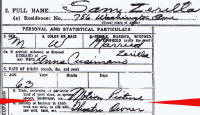 |
|
1917
Directory |
1921 Directory |
Old Daisy 1970 |
Mercurio Maceri Certification |
Sam Zerilla Certification |
|
|
|
|
|
|
|
|
|
|
|
|
|
|
|
|
|
|
|
|
|
Anselmo Barrasso -
Lorenzo, Angelo
and
Nello Pacini
... and
the Metropolitan ... the Venus ... the Palace
... the Savoy Theatres |
| |
 |
 |
 |
 |
 |
 |
|
Anselmo Barrasso |
Marie -daughter |
Venus Theatre |
Venus Ad - 1923 |
Palace Theatre |
Palace Ad |
|
|
|
|
|
 |
Anselmo
Barrasso was associated with the Savoy Theatre as early as 1912 and
the Metropolitan as early as 1917 and then the Venus in 1923.
He built the Palace
Theatre, circa 1919-1920. From 1913-1918, the Venus property
was called the Metropolitan Theater. By 1920 it was called The
Venus, but around 1922, it became The New Grand. This theater
worked well along side the Palace, which was the largest vaudeville
house for Blacks in the South. Every major
African-American entertainer performed at the Palace. Angelo,
Lorenzo and Nello Pacini were co-owners of The Palace. Anselmo continued to manage the Palace until 1964.
He died in 1967. After his death the theater fell into
disrepair. The top floor was removed in the 1970s, and the building was
later demolished. |
| |
|
|
|
Lorenzo Pacini was born in Valdottavo, Italy in 1865 and immigrated
to the U.S. He died in Memphis in 1939.
Joseph A. Pacini was born in Memphis in 1898 and died in 1952. The Barrasso
brothers (F.A. Barrasso) were instrumental, with Sam Zerilla in
organizing a circuit for Black performers (TOBA). Although
TOBA did nothing about the low wages and poor working conditions, it
did offer work for black artists when there otherwise might have
been none. |
|
|
 |
 |
 |
 |
 |
|
Lorenzo Pacini 1930 |
"Joe" Pacini 1924 |
Pacini Family 1924 |
Nello Pacini |
Anselmo
Barrasso -
1908 |
|
|
|
 |
 |
 |
 |
 |
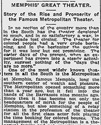 |
|
1912 - Savoy |
1917 - Metropolitan |
1920 Palace |
1923 Palace - Venus |
1938 - Palace |
Metropolitan-1913
|
|
|
|
|
|
|
|
|
|
| |
| |
|
Dave Lebovitz ...
and the Georgia ... Ace ... Harlem Theatres |
|
|
|
Dave
Lebovitz built the Georgia in 1920, the Ace in 1930, and the Harlem
in 1935. He died in 1988. |
|
|
|
Please help us
locate a photo
of Dave Lebovitz? |
|
 |
 |
 |
 |
| |
Georgia Building today |
Dave
Lebovitz
Marker |
1937 Harlem List |
1943 Ace List |
|
|
|
|
|
|
|
|
|
|
|
|
Michael
and
Augustine Cianciola
...the Rosemary ... Luciann ... Rosewood
Theatres |
|
|
 |
 |
 |
 |
|
Augustine
Cianciola |
A. Cianciola
Family 1952 |
Rosmary
|
Luciann |
|
|
|
|
Michael
Cianciola built the theaters and his son Augustine managed them.
The Rosemary is named after Michael's sister Rosemary. The
Luciann is named after Michael's sisters Lucy and Ann Cianciola.
The Rosewood is named after
? Dates of opening: Rosemary
1930...Luciann 1939...Rosewood 1950. |
|
|
|
Please
help us
locate a photo of
Michael Cianciola? |
|
 |
|
|
 |
 |
| |
Augustine
Cianciola '55 |
|
|
Theatres
1955 |
Rosewood |
|
|
|
|
|
|
|
|
|
|
|
|
Alfred and Irene Suzore ...
and the Suzores #1 ...Suzores #2 Theatres |
|
|
|
Please help us
locate a photo
of
Alfred Suzore ? |
|
 |
 |
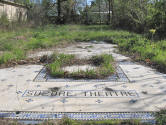 |
| |
Suzores #1 |
Suzores #2 |
Suzores Tile floor |
|
|
|
 |
Alfred
Suzore was born in 1888 and died in 1975. The Suzores
were "movie people" and had an apartment over their Jackson
Avenue theater where they often stayed. They also had a farm
near Shelby Forest. In addition to their own theaters, they had managed the
Bristol
for some time. By all accounts, Alfred was not the most
agreeable personality and was considered quite "stingy" and "cheap".
His movie houses were not well maintained. In 1952 there was an auction of the Suzores #1 on Jackson to pay off
a $14,000 judgment against Alfred Suzores, which a circuit jury
awarded to James Rutherford, who was shot by Suzore in 1950. Suzore claimed self-defense. This must
have been resolved at a later time, because the Suzores
were still operating the #1 theatre much later. The Suzore
Theatres will always be remembered as the favorite theatre of the
young Elvis. And those who attended the theaters have their
favorite stories of mice running around their feet. |
|
Lawsuit
|
|
|
|
 |
 |
 |
|
 |
|
1915 For Sale |
|
 |
|
 |
|
Suzores #2 |
Billboard 1949 |
1940 |
1953 Ad |
Suzore Certification |
|
|
|
|
|
|
|
|
|
|
|
|
M. A. Lightman ...
and the Malco ...
Memphian ... Crosstown Theatres |
|
|
 |
 |
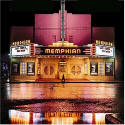 |
 |
 |
|
M.A. Lightman |
Joe Lightman |
Memphian |
Malco - 1959 |
Crosstown |
|
|
|
|
Morris A. Lightman was the son of
Hungarian immigrants. Although he held a degree in engineering
he thought of himself more as a showman and entertainer. When
he saw a long line of people waiting to get into a local theatre, he
decided that he wanted to operate a movie theatre. In Atlanta
he made a contact in the theatre business and learned the art of
movie exhibition. By 1915 Lightman had opened his first
theatre in Alabama, and within 6 months had opened 2 more -
immediately selling them and receiving a 50% share of a theatre in
Little Rock. Then he partnered with his father, Joseph, a
stone construction contractor, to build a Theater in Nashville.
But in Little Rock , Lightman partnered with M. S. McCord and M. J.
Pruniski and formed the Malco Amusement Company. They began
building a theatre chain by buying and building single screen
cinemas throughout Arkansas. In 1926 they took on two more
partners, W. F. McWilliams and L. B. Clark, which gave them 32
theatres. 1926 marks the year the company began installing
sound equipment in all their theatres. In 1929
Malco Theatres purchased their first location in Memphis and opened
the Memphian Theatre. By 1940, after the heyday of vaudeville, the Orpheum Theater
at Main and Beale was purchased
by the Malco chain and switched to a movies-only format. This opulent
movie palace became the base of operation for Malco Theatres. The renamed MALCO
Theater continued to run first-run films until it closed in 1977.
In 1951, Malco Theatres opened The Crosstown. The Malco
company always displayed a passion for the movie business and was on
the cutting edge of technology in presentation, seating and sound.
M. A. Lightman was highly respected throughout the industry.
 |
Of
course the name MALCO comes from M. A. Lightman Co. The
legacy of the company, now in its fourth generation, has been
passed to Stephen Lightman, Jimmy Tashie, and Bobby Levy.
The three share ownership responsibilities and insist their
ability to work together throughout the years has saved the
family from separation. The Lightman family is
known for owning Malco Theatres, but the Lightman Bridge Club
was named in honor of M.A. Lightman, who was an excellent
player and played in many national tournaments. u |
|
|
|
 |
 |
 |
 |
|
Linden Circle |
Princess |
Ridgeway 4 |
Studio on the Square |
| |
|
|
|
|
|
|
|
Chalmers Cullins . Edward Cullins
. Nate Evans
...and the Savoy ... Idlewild
... W. C. Handy Theatres |
|
|
 |
 |
 |
 |
 |
|
Chalmers Cullins |
Father-Son |
Chalmers c-1980s |
Chalmers -1956 |
Marker |
|
|
|
|
Born in
1892, Chalmers
Cullins was a member of a theatrical/movie family. While
working as a stage hand at the first Orpheum Theatre he helped save
the costumes of the headliner, Blossom Seeley, from the fire which
destroyed the building in 1923. Nate Evans was an
orchestra leader and conducted the pit orchestra for all shows and
acts at the old Orpheum from the 1920s up to the early 1940s.
He co-managed the Orpheum from 1936-1941. He became partners
with Chalmers to build the Savoy in 1937, and Edward Cullins joined
them later (and others), as partners in building the Idlewild and
the W. C. Handy..
|
|
|
 |
 |
 |
 |
 |
|
ChalmersDaughter |
Chalmers Wife Emily |
1917 Chalmers Draft List |
Directory |
Chalmers Obituary |
|
|
|
 |
 |
 |
 |
 |
|
Idlewild Theatre |
Handy Theatre |
Ed Cullins
-Dale-Roy Rogers |
Nate Evans |
Obit |
|
|
|
|
|
|
|
|
|
|
|
Kemmons Wilson
and Bob Bostick
...
and the DeSoto ...
Princess ..., Airway ... Handy Theatres |
|
|
|
|
|
|
 |
Kemmons
Wilson was a creative thinker who always loved the movies and often
did odd jobs at the Memphian Theatre in return for free admission.
When he realized the theater offered no snacks he saw the
opportunity to create a market for himself. Management agreed
to let him sell popcorn, so he purchased a popcorn machine for $50
and sold popcorn for 5 cents a bag - and quickly was earning $40-$50
per week. The rest is history. Kemmons soon purchased
his own theatre - The DeSoto, built the Airway Theatre, purchased
the Princess, and was partners in the Handy and others.
Of course he was better known for building the Holiday Inn empire at
the same time. Bob Bostick was Kemmons partner in the Movie
Theaters. |
|
Airway Theatre |
|
|
|
|
|
|
|
|
|
|
|
|
|
Arthur Groom
... and Elvis at the Loew's State Theatre |
|
|
 |
 |
 |
 |
 |
|
Loew's
State |
Arthur
Groom - Elvis |
with Wink Martindale |
with "Hoppy" |
Groom - seated, left |
|
|
|
|
Long time
Loew's State manager Arthur Groom stepped into the history books in
1950 when he fired usher Elvis Presley for either "being late" or
"fighting with another employee" - depending on the legend you read.
Years later, both of them were good sports about it and posed for
the above photo with Elvis' old uniform. Indeed, most of
Elvis' movies premiered at Loew's State. Business was always
good. |
|
|
|
Micki Groom Creamer: "My
Dad was the manager of the Loew's State from 1949 till the mid 1960's, not too sure.
As many may know, my Dad did fire Elvis Presley when he was an usher
scuffling with another usher in the early 50's, but eventually hired him
back. Truly amazing....a kid is an usher and about 5 years later, he is
coming back to see himself up on the screen. That was quite a night. My
Dad held a private screening for Elvis, his parents, and friend visiting
from Hollywood, Nick Adams, and of course the Groom family was there in
full force! I was a candy girl at the Loew's State during my
high school years and met my future husband who was an usher at Loew's
Palace". |
|
|
|
|
|
|
|
|
|
|
|
...Lloyd T. Binford ...
Memphis Censor |
|
|
 |
 |
 |
 |
 |
 |
|
Pearl Bailey |
Ingrid Bergman |
Lena Horne |
Charlie Chaplin |
Our Gang |
Jane Russell |
|
|
|
 |
Lloyd T. Binford - notorious censor of Memphis.
50% of the city loved him, the other 50% hated him.
Hollywood detested him. No one knows why Binford was
picked by "Boss" E. H. Crump to head the Memphis Censor Board
in 1928. His background in Insurance certainly didn't
qualify him to become an arbiter of public taste. His
reasons for banning certain films and plays was just as
confusing. He banned all Charlie Chaplin films, cut Lena
Horne's scenes, banned all Ingrid Bergman films after her
affair with director Rossellini, banned "Our Gang" because a
black child played with white children, cut Peal Bailey
scenes, and Jane Russell in "The Outlaw" really caused him to
lose sleep. Because he had once been involved in a train
robbery, he banned any movie containing a train robbery, and
he banned the road show of the musical "Annie Get Your Gun",
because there were blacks in the cast who mingled with whites. |
| |
|
|
|
But
some Memphians actually thought he wasn't tough enough, even
after Collier's Magazine, Time, Variety, and The New York
Times denounced him and ridiculed Memphis for giving him so
much power. But Binford stayed at it until 1956, when he
resigned, shortly before his death. Ironically nothing
has been "Banned in Memphis!" since that time, although the
musical "Hair" did cause quite a stir.
|
|
|
|
|
|
*
New Memphis.Memphis.Crisp's
Gaiety.Leubries Theatres are on another page of this website
>
Click here
*
National.Varieties.People's.May's Bijou.Gentry's.Olympic are on another page of this website
>
Click here |
|
|
|
|
|
|
|
|
|
|
|
|
|
|
Memphis Showmen Memorabilia
|
|
|
|
|
|
|
|
 |
| |
|
|
|
Re:
Blue Laws |
|
|
|
|
|
|
|
|
Credits |
|
|
|
The
Historic-Memphis website does not intentionally post copyrighted
photos and material without permission or credit.
On
occasion a "non-credited" photo might possibly be posted because we
were unable to find a name to give credit. Because of the nature of
our non-commercial, non-profit, educational website, we strongly
believe that these photos would be considered "Fair Use. We have
certainly made no monetary gain, although those using this website
for historic or Genealogy research have certainly profited. If by
chance,
we have posted your copyrighted photo, please contact us, and we'll
remove it immediately, or we'll add your credit if that's your
choice. In the past, we have found that many photographers
volunteer to have their works included on these pages and we'll
also do that if you contact us with a photo that fits a particular
page. |
|
|
|
The "Historic-Memphis" website would like to acknowledge and thank the
following for their contributions which helped make this website
possible:
Memphis
Public Library, Memphis University Library, Memphis Law Library,
Memphis Commercial Appeal, Memphis Press Scimitar, Shelby County
Register of Deeds, Memphis City Schools, Memphis Business Men's
Club, Memphis Chamber of Commerce, Memphis City Park Commission,
Memphis Film Commission, Carnival Memphis, Memphis Historical
Railroad Page, Memphis Heritage Inc, Beale Street Historic District,
Cobblestone Historic District, Memphis Historic Districts, Vance
Lauderdale Family Archives, Tennessee State Archives, Library of
Congress, Kemmons Wilson Family, Richard S. Brashier, Lee Askew,
George Whitworth, Woody Savage and many individuals whose assistance is
acknowledged on the pages of their contributions. Special
thanks to Memphis Realtor, Joe Spake, for giving us carte blanche
access to his outstanding collection of contemporary Memphis photos.
We do not have high definition copies of the photos on these
pages. If anyone wishes to secure high definition photos,
you'll have to contact the photographer or the collector.
(To avoid any possibility of contributing to SPAM, we do not
maintain a file of email addresses for anyone who contacts us). |
|
|
|
|
|
|
|
|
|
|
|
|
|
|
|
|
|
|
|
|
|
|
|
|
| |
|
|
| |
|
|
| |
|
|